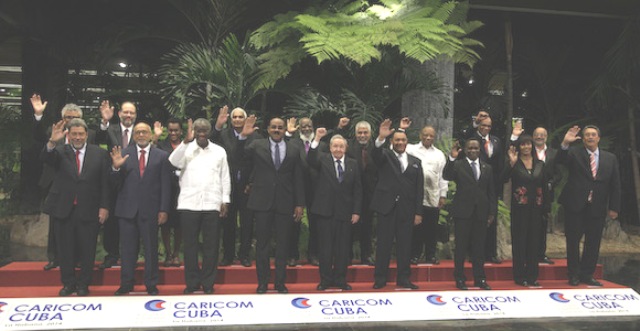A crowded space - Latin American & Caribbean

By David Jessop
Tweet



When it comes to regional and hemispheric institutions, the Caribbean and Latin America have become a crowded space.
Over the last few years an extraordinary number of bodies have appeared; expanding their agendas to promote regional integration, sustainable development, political cooperation, a single approach in international forums, and the promotion of dialogue with other states and institutions.
Three examples will suffice.
The first is the Caracas-based Community of Latin American and Caribbean States (CELAC) that met in Ecuador in late January, agreeing a wide-ranging action plan. This politically significant grouping is now focussing on delivering an expanded economic and environmental agenda. Not only does CELAC bring together all of the countries of the Americas other than the US, Canada and all non-independent overseas territories, but it has also become a primary focus for the European Union’s and China’s relations with the Americas, and is intent on developing a similar interface with Russia, India, Korea and Turkey. Moreover, some countries like Cuba and Venezuela clearly regard it as the future authentic alternative to the Organisation of American States (OAS).
Then there is the Trinidad based Association of Caribbean States which met in Havana on June 4. This grouping, which is being reinvigorated under the pro-tempore presidency of Cuba, adopted at the end of its meeting a 44-point declaration and an eleven-page two-year plan of action, requiring extensive work by its secretariat on many of the same issues that were addressed in Ecuador by CELAC. The institution includes all of the countries of the Caribbean and Central America plus Venezuela and Mexico and unusually, the region’s overseas territories and the French DOM as associate members, but not Puerto Rico or the USVI. As with CELAC it has a wide range of international observers and relationships.
And thirdly, there is the Washington based General Assembly of the Organisation of American States (OAS), which will meet in the Dominican Republic from June 13-15. Unlike the other two bodies, the OAS is an orphan of the cold war. It includes the United States and almost all of the independent nations in the Americas. The exception is Cuba which, while a member, has said that it will never re-join as it regards the body, in the words of President Castro, as “an instrument of imperialist domination.” The OAS too is developing a work programme that goes far beyond the political, and has many international observers and extra-hemispheric relationships.
There are also many sub-hemispheric and cross-cutting groupings. They include for the Caribbean and Central America, CARICOM, the OECS, and SICA; the overlapping mechanisms and memberships of nations that are members of ALBA, the Bolivarian Alliance; and now newer relationships such as, for example, Suriname and Guyana’s membership of the Organisation of Islamic Cooperation.
Re-positioning
Why this complexity has come about is partly a function of history, a consequent desire to reinforce south-south relations, and to develop an authentic voice that is demonstrably separate from the US and independent. It responds to a wish for alternative hemispheric leadership. It is also in part a reflection of the once high oil price and its ability to fuel the rise of left-leaning social movements in the Americas while enabling new forms of hemispheric support. More generally, it is a response to changed thinking about the re-positioning of the Americas in a multi-polar world.
For CARICOM the welcome rise of CELAC in particular, raises questions about how best to engage to ensure the sub-region’s voice is heard on issues that are of particular concern to small states, and how to ensure that the unique identity of the region’s 5.5m English speakers is maintained in an organisation representing 600m people.
More importantly, it is about the how the region intends taking advantage of the economic opportunity closer relations offer for growth through trade and investment. In this respect it is unclear if CARICOM has any plans to take advantage of the more rapid economic progress of its Hispanic neighbours in both the Caribbean and Central America.
Working better together
Nevertheless, the ACS summit, did offer some initial thoughts. The final declaration spoke about the importance of functional co-operation in ‘uniting’ all ACS members by developing air and sea routes and multi- destination tourism. It also noted the significance of the Panama Canal expansion for regional economic development, and proposed establishing a working group to consider how tariff preferences might be adapted to encourage intraregional trade.
However, there was no indication about who would deliver this, how the private sector is to be engaged in the process, where such initiatives might fit with the work already being undertaken by bodies such as Caribbean Export, or any objective time scale in which practical outcomes are to be achieved.
Moreover, a tortuously worded paragraph in the ACS Declaration on working towards the consolidation of CELAC made clear in part ‘the importance of also fostering coordination and articulation with other regional and sub regional mechanisms and organizations, in particular CARICOM, OECS and SICA,’ suggesting there is concern in the sub-region that its institutions may be eclipsed.
What is apparent from the emergence and growing strength of the new platforms is that relationships in the Americas have changed profoundly.
It suggests a high degree of hemispheric solidarity is here to stay.
US perspective
Moreover, the future scenarios for political change in Washington suggest that this process of consolidation in the Americas will continue and be reinforced. US policy will either be more of the same under Hilary Clinton, or result in a dramatic reinforcing of solidarity in the Americas if her Republican opponent were to emerge as the winner and seek to implement his extraordinary and implicitly racist policy in relation to Mexico.
At present the ACS and CELAC mean little in relation to the Caribbean’s struggling economic integration process, but it is clear that some members of CARICOM are now looking for new ways to stimulate growth by linking their development to Spanish speaking neighbours in the region.
The growth in the number of bodies in which the region is now involved suggests that not only is new thinking about the path to economic integration required, but thought needs to be given as to how CARICOM and the single market are to relate to the long term structural changes that are taking place in the hemisphere.
David Jessop is a consultant to the Caribbean Council
He can be contacted at david.jessop@caribbean-council.org
Previous columns can be found at www.caribbean-council.org
10 June, 2016
Other Caribbean background articles can be found on Intelligent Thinking.



